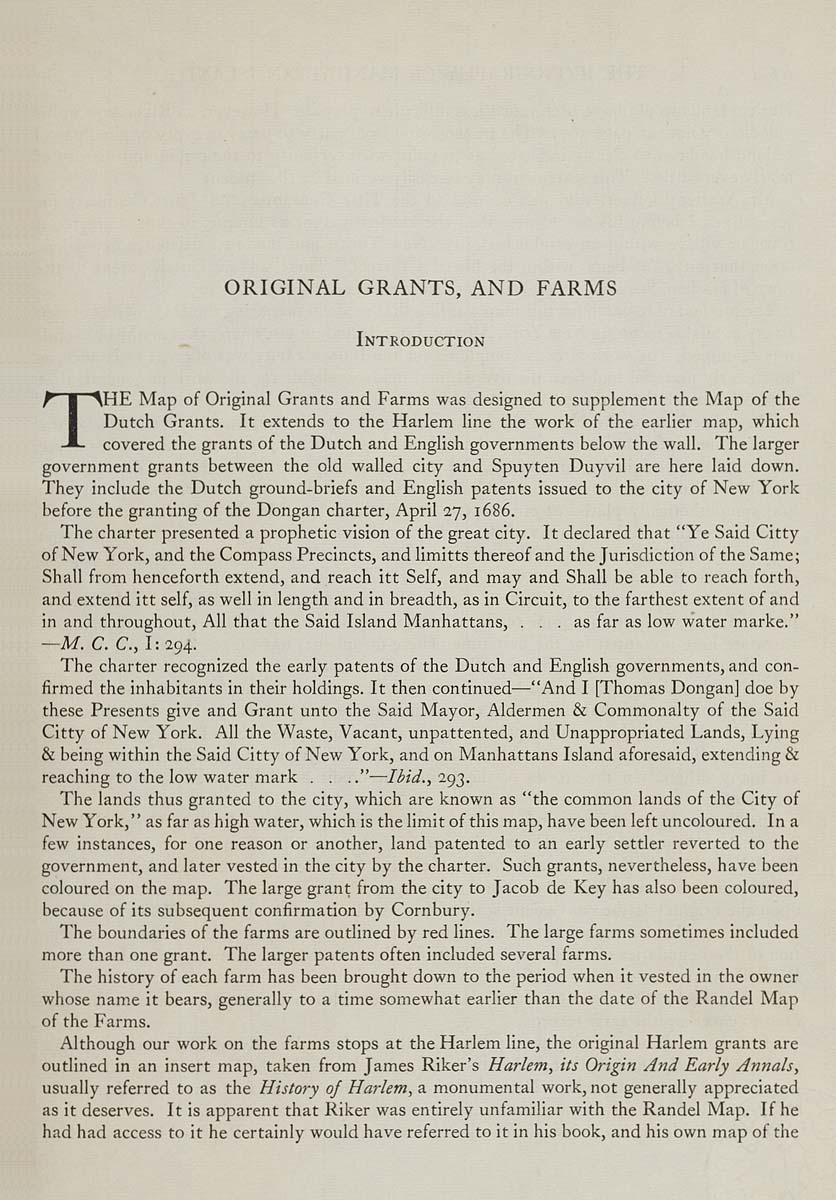ORIGINAL GRANTS, AND FARMS
Introduction
THE Map of" Original Grants and Farms was designed to supplement the Map of the
Dutch Grants. It extends to the Harlem line the work of the earlier map, which
covered the grants of the Dutch and English governments below the wall. The larger
government grants between the old walled city and Spuyten Duyvil are here laid down.
They include the Dutch ground-briefs and English patents issued to the city of New York
before the granting of the Dongan charter, April 27, 1686.
The charter presented a prophetic vision of the great city. It declared that "Ye Said Citty
of New York, and the Compass Precincts, andHmitts thereof and the Jurisdiction ofthe Same;
Shall from henceforth extend, and reach itt Self, and may and Shall be able to reach forth,
and extend itt self, as well in length and in breadth, as in Circuit, to the farthest extent of and
in and throughout. All that the Said Island Manhattans, ... as far as low water marke."
~M. C. C, 1:294.
The charter recognized the early patents of the Dutch and English governments, and con¬
firmed the inhabitants in their holdings. It then continued—-"And I [Thomas Dongan] doe by
these Presents give and Grant unto the Said Mayor, Aldermen & Commonalty of the Said
Citty of New York. AU the Waste, Vacant, unpattented, and Unappropriated Lands, Lying
& being within the Said Citty of New York, and on Manhattans Island aforesaid, extending &
reaching to the low water mark . . .."—Ibid,,i<)T,-
The lands thus granted to the city, which are known as "the common lands of the City of
New York," as far as high water, which is thelimit of thismap, have been left uncoloured. In a
few instances, for one reason or another, land patented to an early settler reverted to the
government, and later vested in the city by the charter. Such grants, nevertheless, have been
coloured on the map. The large grant from the city to Jacob de Key has also been coloured,
because of its subsequent confirmation by Cornbury.
The boundaries of the farms are outlined by red lines. The large farms sometimes included
more than one grant. The larger patents often included several farms.
The history of each farm has been brought down to the period when it vested in the owner
whose name it bears, generally to a time somewhat earlier than the date of the Randel Map
of the Farms.
Although our work on the farms stops at the Harlem line, the original Harlem grants are
outlined in an insert map, taken from James Riker's Harlem^ its Origin And Early Annals,
usually referred to as the History of Harlem, a monumental work, not generally appreciated
as it deserves. It is apparent that Riker was entirely unfamiliar with the Randel Map. If he
had had access to it he certainly would have referred to it in his book, and his own map ot the
|








